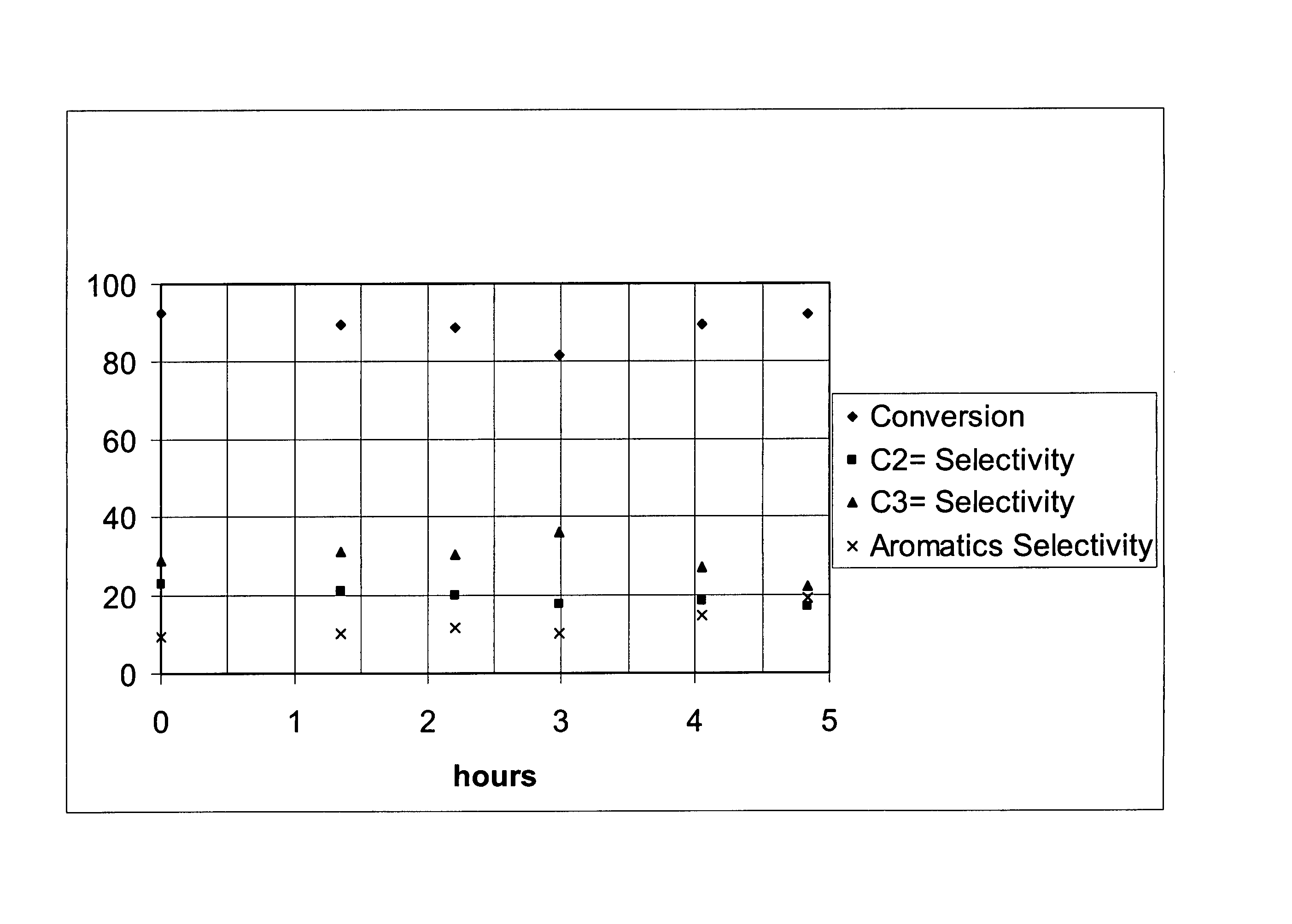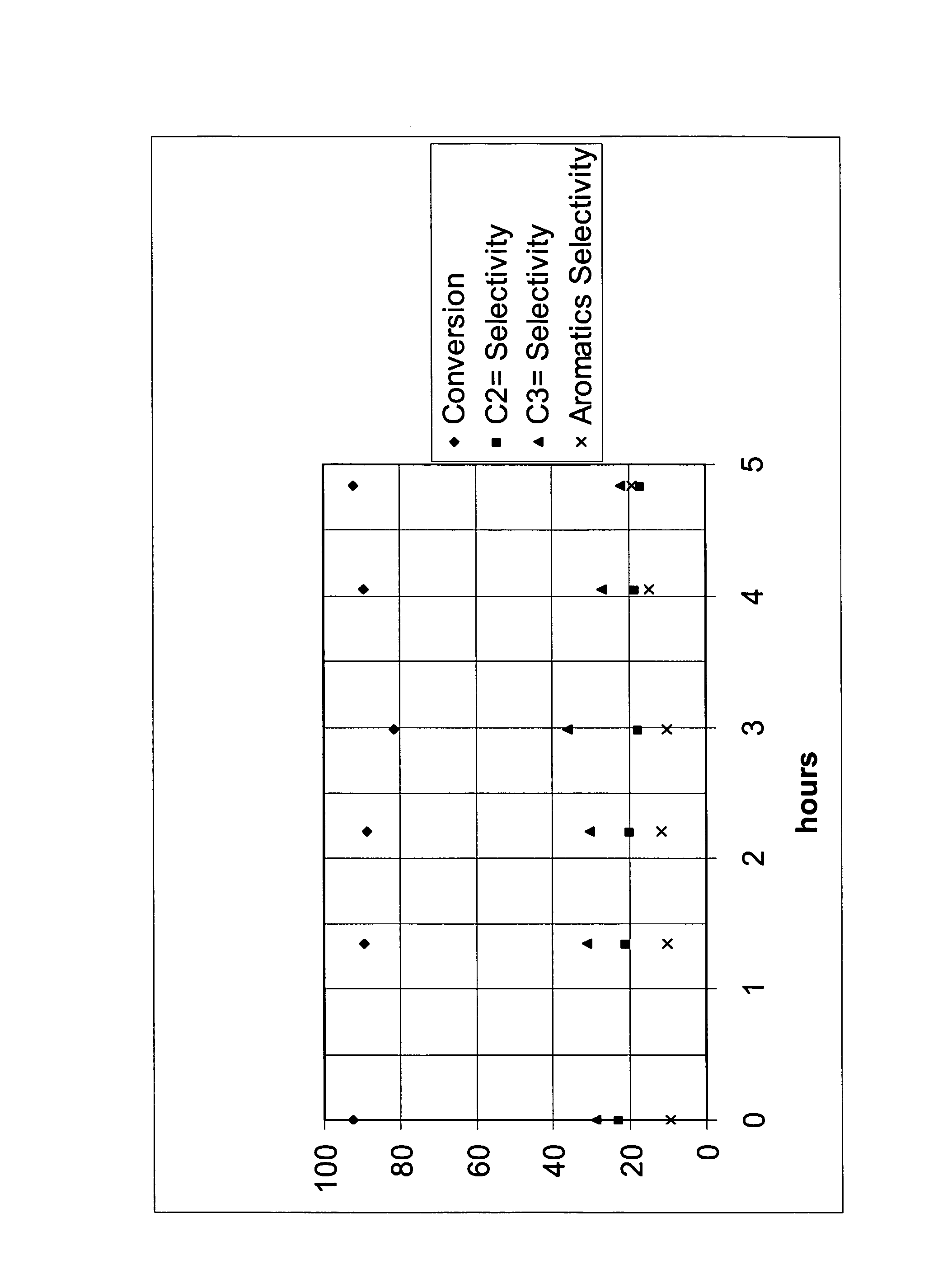Nanocrystalline silicalite for catalytic naphtha cracking
a technology of nanocrystalline silicalite and catalytic naphtha, which is applied in the direction of organic chemistry, chemical apparatus and processes, hydrocarbon oil treatment products, etc., can solve the problems of low propylene-to-ethylene ratio and the complex combination of reaction and gas recovery systems of the ethylene plant, and achieves high silica-to-alumina ratio, small crystal size, and high conversion and selectivity.
- Summary
- Abstract
- Description
- Claims
- Application Information
AI Technical Summary
Benefits of technology
Problems solved by technology
Method used
Image
Examples
example 1
[0025]Nano-silicalite was used in catalytic naphtha cracking tests against a coventional silicalite catalyst with a high silica / alumina ratio, and a ZSM-5 with a relatively low silica / alumina ratio. The conventional silicalite catalyst had crystals 10 to 20 times the characteristic size of those in the nano-silicalite. The conditions of the experiments were: reactor inlet temperatures of about 650° C., and inlet total pressure of about 120 kPa (3 psig). The ratio of catalyst to naphtha feedstream based on mass was about 40 in a fixed bed reactor. The injection time for the feed over the catalyst was 48 seconds. This experiment simulated an FCC-type operation where the molar ratio of diluent nitrogen to naphtha feedstream was 2.6.
[0026]
TABLE 1Catalystsmicropore% zeoliteSi / Al2morphology ofvolume, cc / gZeolitein catalystratiocrystals(zeolite only)Nano-Silicalite10056750-100 nm0.153Silicalite1003481-2 micron cubes0.173and cylindersZSM-580381-2 micron cubes0.167and cylinders
[0027]The resu...
example 2
[0029]FCC-type catalytic naphtha cracking tests were run with naphtha injected using nano-silicalite. The reactor system had catalyst introduced at 650° C. and at 168 kPa (10 psig) total pressure. The naphtha was reacted for 3 seconds with no diluent gas, followed by an injection of a purge gas, N2, to remove the products from the reaction zone. The product was collected in a heated glass syringe and then injected into the on-line GCs for analysis. A series of experiments involved studying the effect of the silica to alumina ratio on per pass conversion and selectivity.
[0030]
TABLE 3Performance vs. silica / alumina ratioSi / Al2 ratio63481911301430conversion, %91.490.385.787.5selectivities, %Methane3.83.53.23.3Ethane6.05.65.35.5Ethylene23.723.521.123.0Propane7.58.16.36.6Propylene31.032.136.735.5total C4s12.913.815.614.6C10+2.52.84.63.8Aromatics11.69.86.67.0Hydrogen0.80.80.60.7Coke0.2000Sum100100100100ethylene + propylene54.755.657.858.5propylene:ethylene1.311.371.731.54
[0031]Table 3 show...
example 3
[0032]Nano-silicalite was tested for an FCC-type catalytic naphtha cracking processes, and was compared with conventional steam cracking. The steam cracking performance was simulated using Pycos. The catalytic naphtha cracking reaction conditions were a pressure about 168 kPa (10 psig), a temperature for the nano-silicalite experiments of about 650° C. at inlet, and with no diluent gas used in these experiments. The injection time for the feed was 3 seconds, and the catalyst to naphtha feed ratio was 40. The steam cracking was simulated at a temperature of 835° C. with a steam to naphtha ratio, by weight, of 0.4.
[0033]
TABLE 4Comparison with steam crackingNano-silicaliteCatalystSteam Cracking(Si / Al2 = 634)Conversion, %91.391.4Selectivities, %Methane17.23.8C2, C3 acetylenes1.5Not detectedEthylene33.723.7Ethane4.16.0Propylene18.531.0Propane0.47.5Butadienes5.7Not detectedButylenes5.211.0Butanes01.9Aromatics8.511.6CokeLow0.2Carbon oxidesLow0Hydrogen1.10.8C10+4.12.5Total100100Ethylene + p...
PUM
| Property | Measurement | Unit |
|---|---|---|
| temperatures | aaaaa | aaaaa |
| partial pressures | aaaaa | aaaaa |
| vol. % | aaaaa | aaaaa |
Abstract
Description
Claims
Application Information
 Login to View More
Login to View More - R&D
- Intellectual Property
- Life Sciences
- Materials
- Tech Scout
- Unparalleled Data Quality
- Higher Quality Content
- 60% Fewer Hallucinations
Browse by: Latest US Patents, China's latest patents, Technical Efficacy Thesaurus, Application Domain, Technology Topic, Popular Technical Reports.
© 2025 PatSnap. All rights reserved.Legal|Privacy policy|Modern Slavery Act Transparency Statement|Sitemap|About US| Contact US: help@patsnap.com


